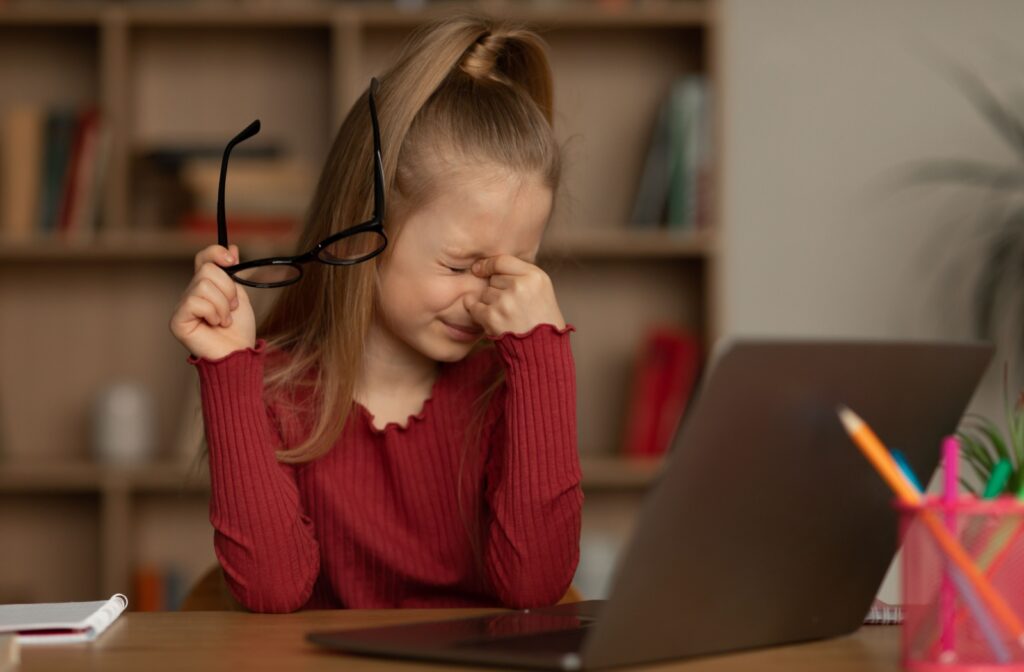Myopia, commonly known as nearsightedness, is increasingly prevalent in children worldwide. Kids lead busy lives packed with schoolwork, playtime with friends, and extracurricular activities. Myopia can impede their ability to keep up with the things they love. If myopia is left unchecked, their vision can worsen as they grow.
With many kids spending long hours on screens or buried in books, parents are naturally concerned about protecting their children’s vision. While myopia can’t be reversed, practical ways to slow its progression and safeguard your child’s eyes include limiting screen time, keeping an elbow-to-hand distance between eyes and screens, and taking regular breaks from screen time.
What Is Myopia?
Myopia is a refractive error in which close-up objects appear clear, but distant objects look blurry. It occurs when the eyeball grows too long or the cornea (the transparent front layer of the eye) is too curved, causing light to focus in front of the retina rather than directly on it.
While myopia can develop at any age, it often starts in childhood and tends to worsen as children grow. Symptoms of myopia usually include difficulty seeing the whiteboard at school, squinting, eye strain, headaches, and needing to sit closer to screens or objects to see them.
What Causes Myopia?
The exact cause of myopia isn’t fully understood, but a combination of genetic and environmental factors plays a role.
- Genetics: If you or your partner are myopic, your child may have a higher likelihood of developing it.
- Screen Time: Prolonged use of screens, such as tablets, smartphones, and computers, particularly at a close distance, can strain young eyes.
- Lack of Outdoor Time: Children who spend less time outdoors are at a higher risk of developing myopia. Sunlight exposure plays a protective role.
- Reading or Close Work: Activities focusing on objects up close for extended periods, such as reading or doing homework, can contribute to eye fatigue and strain.
The 3 Best Ways to Slow Myopia Progression
Slowing myopia progression requires a combination of lifestyle changes and proactive treatments. While genetics play a role in a child’s risk of developing myopia, environmental factors—such as inadequate time outdoors and excessive near work—are key contributors. Here are the top 3 strategies to promote healthy eye development and manage myopia.
1. Prioritize Time Outdoors
Spending time outdoors is one of the most effective ways to reduce the risk of myopia progression. Exposure to natural light and opportunities to focus on distant objects help the eyes grow and function properly. Studies show that children who spend at least 2 hours outside daily are less likely to develop myopia than those who stay indoors. Encourage activities like outdoor play, sports, or family walks to incorporate this healthy habit into your child’s routine.
2. Manage Close Work
Limiting close work—such as reading, screen time, and homework—is not always practical, especially for school-aged children who need the computer for homework or studying, but it is important to encourage breaks and alternate activities that involve distance vision. This can include going for a walk or playing outdoor games during study breaks.
Encourage your child to balance close-up tasks with outdoor activities or hobbies that engage their distance vision.
3. Explore Myopia Management Options
Lifestyle changes are essential, but myopia management can supplement eye-healthy habits. While these strategies won’t reverse existing myopia, they can prevent further worsening—a key factor in reducing the risk of serious eye conditions later in life.
Options include:
- Multifocal contact lenses: Specially designed to reduce the rate of eye growth.
- Atropine eye drops: A prescription treatment that helps slow the progression of myopia in children.
Unmanaged myopia can lead to stronger prescriptions and increased risks of complications, such as retinal detachment, glaucoma, or macular degeneration. Talk to your optometrist about options for protecting your child’s long-term eye health.

6 Additional Tips for Supporting Healthy Eye Development
1. Schedule Regular Eye Exams
The first step in managing your child’s myopia is early detection. Schedule annual eye exams with your child’s optometrist. Consistent check-ups will allow your eye doctor to monitor changes in their prescription.
2. Create Screen-Free Zones
Set up a “screen-free” zone in your home, especially during meals or before bed. Limiting screen time not only reduces eye strain but also promotes better sleep and family bonding.
Experts recommend avoiding screen time entirely for infants, while children under 4 should have no more than an hour of sedentary screen use per day. For kids aged 5–17, aim to keep recreational screen time under 2 hours a day.
3. Follow the Elbow Rule
Any time your child uses a computer or other device, ensure their screen is positioned at eye level or slightly below to avoid neck and eye strain. Remind them to maintain an elbow-to-hand distance between their eyes and screens or books. This simple trick helps them avoid bringing objects too close to their face, reducing strain and supporting healthy vision habits.
4. Follow the 20-20-20 Rule
To reduce high demand on the visual system, take regular breaks from reading or screen time.
The 20-20-20 rule is a simple and effective way to give your eyes a rest: Every 20 minutes, take a 20-second break and look at something at least 20 feet away. This quick reset helps prevent eye fatigue and keeps your kid’s visual system refreshed throughout the day. And this tip works for adults, too!
5. Provide Adequate Lighting
Ensure your child’s study or play area is well-lit. Poor lighting causes the eyes to work harder, leading to strain. Opt for natural lighting whenever possible, or use an anti-glare lamp to reduce reflective glare on books and devices.
6. Promote a Balanced Diet
A nutrient-rich diet supports overall eye health. Include food with high levels of vitamin A (found in carrots, sweet potatoes, and spinach), omega-3 fatty acids (salmon, walnuts, flaxseeds), and lutein (kale, eggs). Hydration is equally important to maintain eye moisture.
Help Your Child See the World Clearly
Managing and mitigating myopia doesn’t have to be overwhelming. Combining appropriate lifestyle changes with professional guidance can significantly improve your child’s eye health and prevent worsening.ProOptix Optometry & Dry Eye Center knows routine eye care for kids is crucial in proactive and preventative vision care. Contact us today to schedule a comprehensive eye exam or explore myopia management plans if your child displays signs of myopia.





